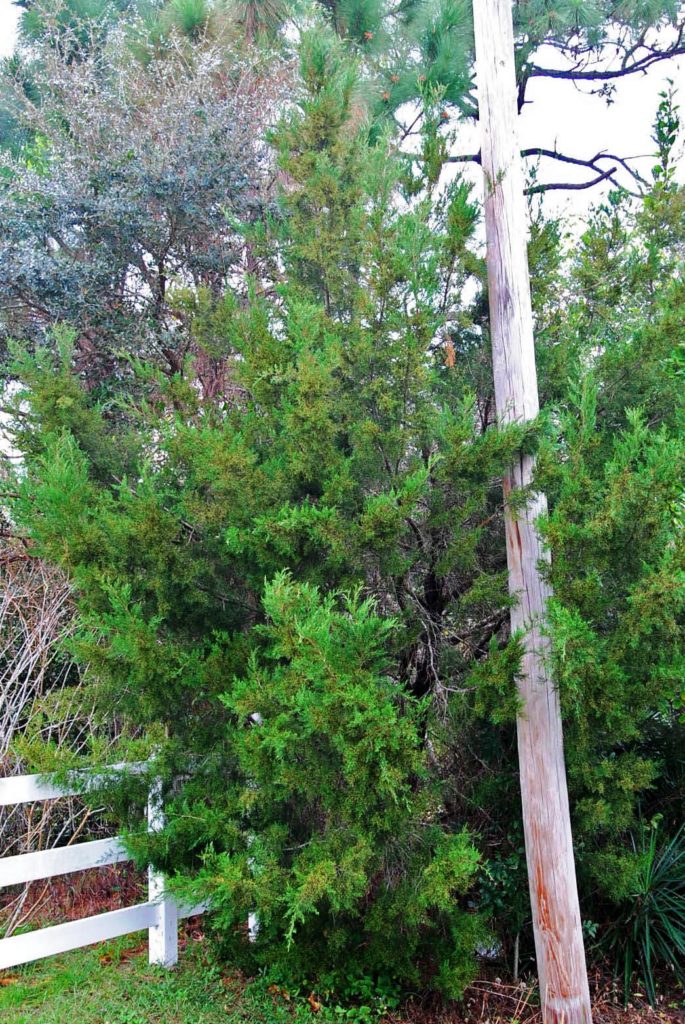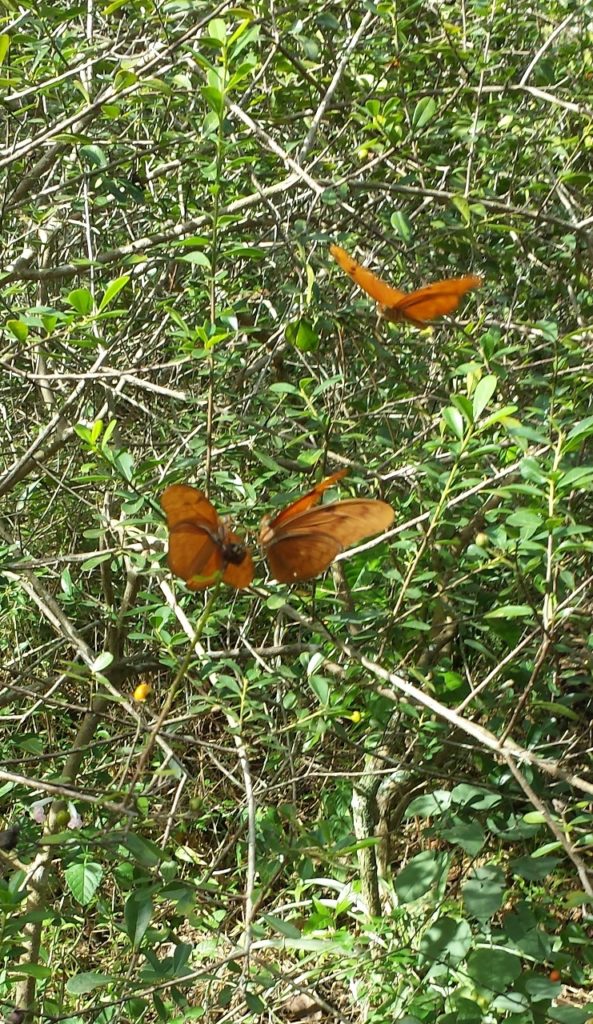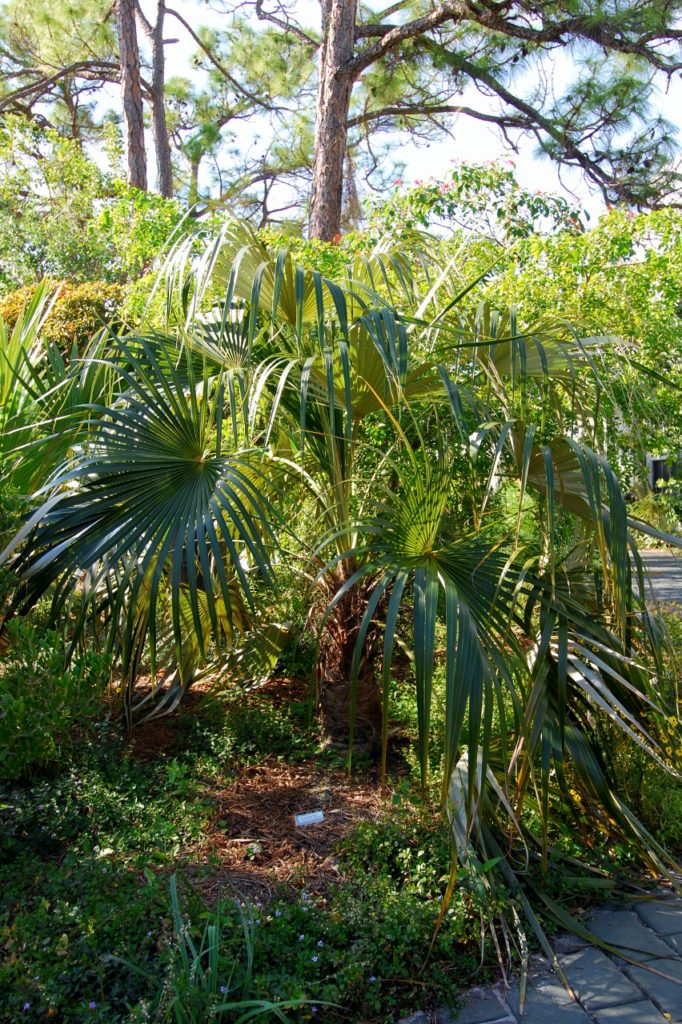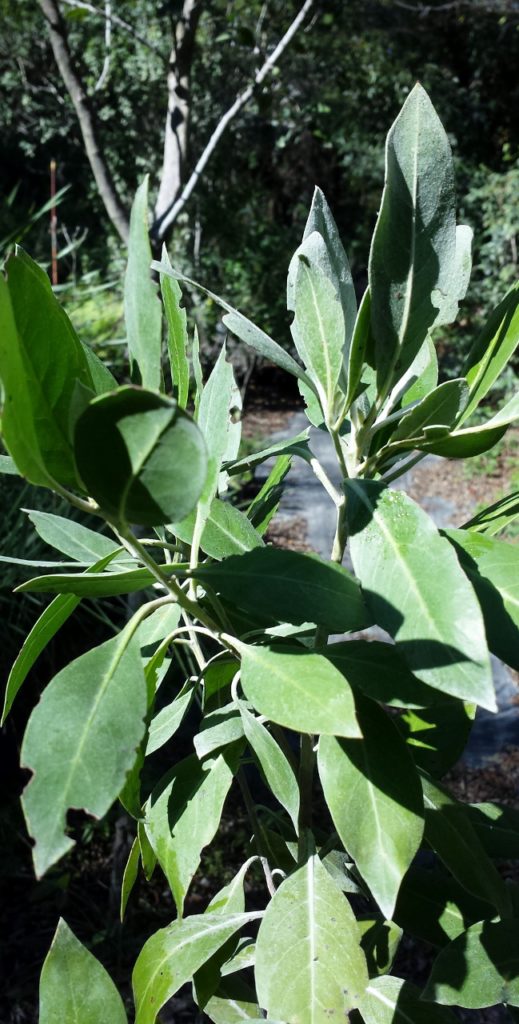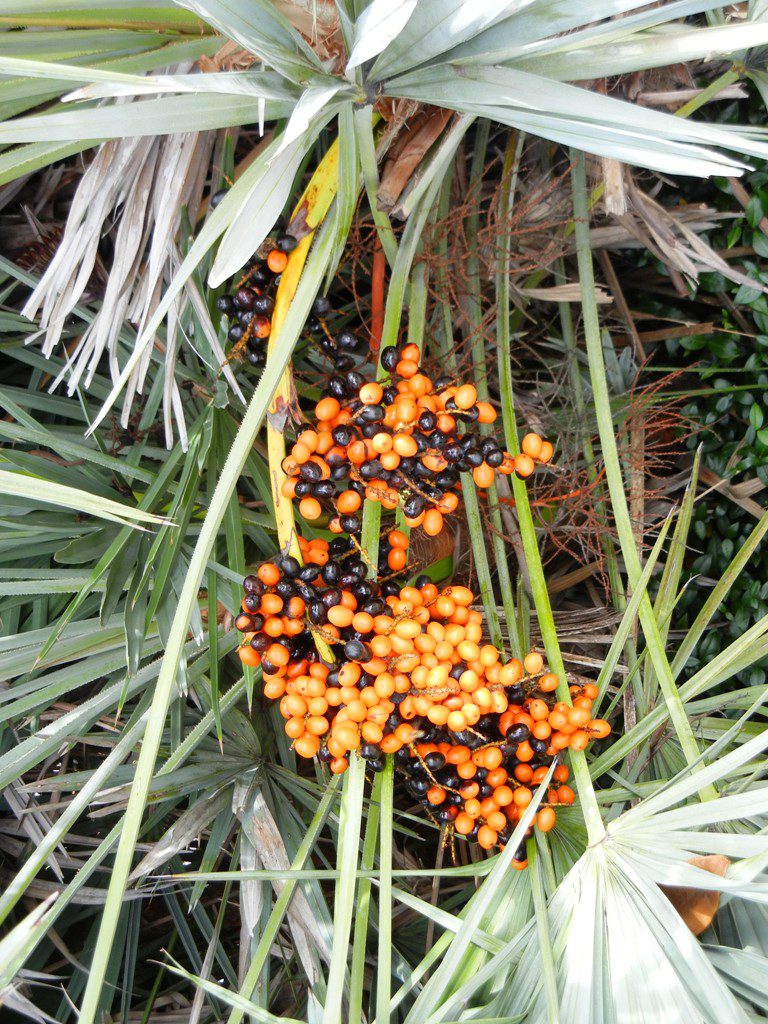Southern Red Cedar
Juniperus silicicola
Our Southern Red Cedar, which has made friends with this telephone pole, is found from North Carolina to Central Florida and also west along the Southern United States to California.
It can grow to 50 feet or more and be limbed up to make a wind resistant street tree or kept as a round or pyramid shaped windscreen. Give it several feet of space from the nearest sidewalk or road, as the branches of young trees are wide and go to the ground.
Southern Red Cedar is dioecious, producing male or female flowers on separate trees. The female flowers are wind pollinated, so it is necessary to have a male tree up wind (southeast) of a female one. I find that female plants are rare, so you may want to purchase an older tree in fruit to make sure you have a female or one that is grown from a female cutting.
The small, resinous fruit has a bluish covering which is composed of wild yeasts. A couple of berries can be added to your sourdough starter for a few hours and then removed. Eating more than a couple of berries may cause stomach problems. See this article for more info.
Bobwhite, mourning doves, cedar waxwings and 50 other birds feed on the berries. The needles are sharp and dense which makes this an excellent tree for birds to nest in because predators will stay out of it.
Southern Red Cedar is found on coastal dunes and along the edge of saltmarshes. They are salt air and water tolerant and will grow anywhere in Florida. It does not occur in South Florida naturally, yet does well here.
Try a salt marsh theme when planting this tree. Mix it with Saw Palmetto, Wax Myrtle, Saltbush, Sand Cordgrass, both species of Beach Elder, Yaupon Holly, Dahoon Holly, Christmas Berry and Sea Oxeye. Place Slash pine, Southern Magnolia, and various oaks in the background, far enough away that they won’t crowd the cedars.
A coastal theme includes, Southern Magnolia, Red Bay, Hackberry, Tough Bumelia, Simpson Stopper, Yaupon Holly, Live Oak, Saw Palmetto, American Holly and many beach grasses and wildflowers.
If your tree becomes too tall, try removing a portion of the main leader back to a side branch at an appropriate height and encourage a wind swept look. In North Florida, the larva of the juniper hairstreak butterfly feeds on the foliage.
For more Info.
Soldierwood
Colubrina elliptica
With a beautiful trunk, plated with chunks of orange – brown bark and a height of only 20 to 40 feet, Soldierwood is one of the most interesting medium sized trees to plant near a home. When mixed with Gumbo Limbo, Simpson Stopper and other plants with exfoliating bark, the effect is enchanting.
This endangered tree is found only in the Upper Keys and Biscayne National Park. It is not salt tolerant, yet is very drought tolerant.
The tiny seeds of Soldierwood make a soft popping sound as they explode from their quarter inch round pod. Stand under a tree in late summer and listen to the sound as the pods heat in the sun and the seeds are ejected.
Although not a berry producing tree, the bark hides insects for the birds to find. The 4 inch light green leaves glow in the light. Try a closely spaced stand of Soldierwood mixed with Willow Bustic, Pigeon Plum, Gumbo Limbo, Wild Tamarind, White Stopper, Milkbark and if you dare, Poisonwood for the look of the dark forests of the Florida Keys.
All of these trees will develope tall straight trunks when planted close together with various shades of white, orange, green, gray, black and brown. Try several of the same tree together to produce a grove that highlights its color.
Soldierwood will branch out when young, so you may need to prune to a single leader.
Now for the fun part:
Maubi, Mauby, Mabi and Mavi.
These are different names for a popular Caribbean drink made from the bark of Soldierwood or its relative Coffee Colubrina, Colubrina arborescens.
This is a bittersweet drink that at first tastes like root beer, but then leaves a lingering bitter taste. It is an acquired taste and is said to lower blood pressure, cure impotence (and then some) along with other ailments. You can find this drink for sale in Caribbean markets. please see for more information.
Click for more info.
Snowberry
Chiococca parvifolia
There are three forms of Snowberry that are now considered to be separate species. Common Snowberry, Chiococca alba, is native from the Keys to Brevard County along the coast. It is the most common species and tends to climb up trees or form a mound of vines.
The pinetorum species has small leaves and is found in the pine rocklands.
The parvifolia species is a ground cover found in the upper keys. This has 1.5 inch leaves that are slightly smaller than the alba species and the stems form a low matt that makes an excellent ground cover in shady to sunny locations.
These species belong to the coffee family and have shiny, dark green leaves. The bruised foliage gives off a chewing gum like fragrance which you may notice when pruning.
When in bloom, the creamy fragrant flowers of all species attract unusual butterflies like the ruddy daggerwing. The clean white quarter inch fruit hang in clusters and are very attractive to birds in late summer. They are not poisonous or tasty.
The parvifolia species in the picture is on the north side of a house and is visited by cardinals feeding on the berries. What a delight to view wildlife so close to a dining room window. A pavonia is also planted here and attracts hummingbirds to its tubular flowers.
Moderate salt air, short periods of freezing temperatures, deep shade to full sun and a month or two of drought are all tolerated by the Snowberries.
Plant the Common Snowberry in rich, dry soil with organic matter. When planting a mixed hedge, put this in the front to add an attractive mounding layer that can stand alone or climb into other trees or shrubs.
Plant both the parvifolia and pinetorum species along the north side of the house as great shade tolerant groundcovers that outperform Jasmine, Green Island Ficus and other overused groundcovers. The larger parvifolia species will also climb into other plants, much like the alba species does.
I have been surprised to find the alba species growing in scrub habitat mixed with Saw Palmetto, Scrub Redbay, Wild Coffee, Hercules Club, Necklace Pod, Dune Sunflower and Scrub Oaks. By adding a little organic matter to the soil, you should be able to grow this species almost anywhere.
alba, parvifolia, pinetorum.
Smooth Strongbark
Bourreria cassinifolia
There are only a few remaining natural locations of Smooth Strongbark shrubs left in Miami-Dade County and the Florida Keys. It is on the State’s endangered species list.
Smooth Strongbark is also called Pineland Strongbark and Little Strongbark. Strongback is also used in reference to a tea make from the leaves in the Bahamas. This tea helps a man do what needs to be done.
The almost constant fragrant white flowers, small orange fruit which is edible but bitter, one inch oval leaves and low height make this a superb border shrub that stays below four feet and can be kept much lower. It is very drought tolerant, yet is not found near salt wind or water conditions or areas that flood.
Several butterflies come to the flowers, and the dried rotting fruit is especially attractive to butterflies like the Julias shown here and Soldiers. Birds love the berries.
The chemicals leaked by the rotting fruit are lapped up by the male butterflies and converted into “perfume” which is given off to attract females. Notice the two male Julias fighting over a dried berry.
There is a much taller cousin, the Bahama Strongbark, that is more common in the upper keys near Key Largo and makes a nice front yard tree. A planting containing both will provide upper and lower canopy cover of similar looking plants.
Try these two and add in Quailberry for the lowest level of cover. Of course, Little Strongbark can be blended with many other hammock species as long as it gets full sunlight. A Florida Keys combination will look the best.
In this case I would combine Lignum Vitae, Joewood, Pineland Croton, Beach Creeper, all of the native palms of the Keys, Black Torch, Florida Boxwood, Coontie, Maidenberry, Sand Cordgrass and numerous other wildflowers to create a stressed look similar to what you might find in the windswept Keys.
Click for more info.
Simpson Stopper
Myrcianthes fragrans
Simpson’s Stopper is found sparingly along the coast from Dade County to Vero Beach. Abundant masses are found along A1A and in inland hammocks from Vero Beach north to St. Johns County.
In the northern part of its range these become up to 20 foot tall shrubs with one inch oval leaves. South at Fern Forest Park, in Broward County, and in the Fakahatchee Strand State Preserve, they become 40 foot or more tall trees with beautiful orange peeling bark and three inch long leaves.
The masses of fragrant white flowers in early summer are followed by bright orange, half inch oval fruit from June to September. These are fought over by local birds and raccoons.
The raccoons break the branches as they pull them down to feed and leave scratches on the bark where they climb. The fruit is sweet and spicy with one to four bitter green seeds inside.
Simpson Stopper grows in average soil, full sun to moderate shade, and has no problem with freezing temperatures or some salt wind. It is moderately fast growing making this a good hedge that fills in quickly, yet needs little maintenance.
Once established it is very drought tolerant. Plant back of the Seagrapes on a dune where only short periods of salt water flooding may occur.
Use as a hedge, specimen tree, mixed with other coastal species or plant in a group in front of a window. The cleaned trunks will frame your view out of the window and with a few well placed lower branches, provide a screen to give you privacy.
This is one of the few native shrubs that is grown extensively commercially. It will last for decades as a clipped hedge and the trunk will stay thin. The only thing it requires is regular watering and fertilizer to establish. If grown in very poor soil, twice a year fertilization may be required.
For a mixed hedge try Simpson Stopper, Spanish Stopper, Jamaica Caper, Florida Boxwood, Myrtle of the River, Wild Coffee, Marlberry, Myrsine, Bitterbush, Crabwood and Locustberry. These are all narrow shrubs that fit together.
click for more info.
Silver Palm
Coccothrinax argentata
The Silver Palm above is in a landscape that receives once a week watering only during the dry season. It is regularly fertilized and has grown from a small 7 gal. size plant into this beautiful specimen in just four years.
This is the most beautiful palm in our state. The upper leaf surface is dark green and the lower is platinum. The sun will reflect off of the lower surface creating a magical shining effect.
Many Silver Palms are found in the lower Florida Keys, especially Big Pine Key. The Rocklands around homestead and near the Miami Zoo also have nice populations.
The tallest specimens are along the beach camping area of Bahia Honda State park. These are ten or more feet tall and when viewed from the water are truly magnificent.
This palm is very tolerant of salt air and short term saltwater flooding. It is found rarely along the coast up to Palm Beach County. Plant it back of the Sea Grapes in full sun to partial shade.
Although drought, poor soil and salt air are tolerated, to get your plant up to a decent size, fertilize and water regularly. No care will be needed once the plant is fully established and the size you want it to be.
The flowers attract bees and the pea size black fruit are usually cleaned off by squirrels and birds as soon as they ripen. This may be annoying if you are planning to germinate these seeds. The berries are not poisonous or tasty.
Silver Palm is great when mixed with other coastal or Keys plants in the front yard or used as a mass planting. On Big Pine Key, it mixes naturally with Key Thatch, Saw Palmetto, Slash Pine and numerous shrubs.
Try a front yard planting mixing Silver Palm, Key Thatch, Buccaneer Palm, Lignum Vitae, Rhacoma, Randia, Beach Creeper, Coontie, Dune Sunflower, Key Lily, Quailberry, a couple of Slash Pine and Black Torch.
You can place a few Silver Palms into the southern, or sunny portions of a coastal hammock planting. Any hammock species can be used.
click for more info.
Silver Buttonwood
Conocarpus erectus var. sericea
The above picture is of a Silver Buttonwood that I found in the Florida Keys. It is not as silvery as the commercial form, yet it provides a relief from the monotony of having one clone used over and over again.
Silver Buttonwood is not really a separate variety, it simply has silver hairs on the leaves and will not come true to seed. It is found naturally in the lower Florida Keys on the higher ground of mangrove swamps.
Both the Green and Silver Buttonwood grow together. Look for various amounts of silver in the Buttonwoods when exploring the lower keys. You may find some with just a little on the new growth and some that are quite silver.
I have not found the platinum color of the commercial Silver Buttonwood anywhere in nature and wonder if this widely used clone is truly native to Florida. It occurs throughout much of the Caribbean region and western Africa.
Silver Buttonwood becomes a 40 foot tree with spreading twisted branches that have moderately thick bark. This makes it a great anchor for bromeliads and orchids. Charcoal from the wood is excellent.
Both the Green and Silver Buttonwood can be used as a hedge plant, but need constant pruning. The Silver will die if planted in too much shade. Better to use both as small trees and plant slower growing, more compact plant species as shrubs.
The fragrant male and female flowers occur on separate plants, although some male flowers will have an ovule. It has been recently observed that the Miami Blue butterfly lays its eggs on Green Buttonwood and goldfinches eat the seeds.
If you are looking for a tree that can tolerate short term salt water flooding, and regular salt air near the dune crest, then this is one of your best choices. On the dune crest mix with Sea Grape, Beach Cocoplum, Native Scaevola, Randia, Sea Lavender and Bay Cedar.
When planting near salt marshes, try a mixture of Silver and Green Buttonwood, Black and White Mangrove, Rhacoma, Limber Caper, Christmas Berry, and Sea Oxeye Daisy.
I have noticed that Buttonwoods growing along mowed roadsides in the Keys adapt by becoming low like a Juniper.
If you remove upward growing shoots, you can train Silver or Green Buttonwood to become a groundcover. Try this with Beach Cocoplum, Beach Creeper and Blackbead for an unusual roadside edging.
click for more info.
Sea Lavender
Tournefortia gnaphalodes
Beautiful blue masses of sea lavender are found naturally along the coast from Key West to Brevard County. Sea Lavender is a member of the Borage family that contains chemicals in its leaves and white flowers that several male butterfly species use to attract their mates.
The rotting leaves release these chemicals. Several male queen and soldier butterflies may gather to drink these chemicals off of the foliage.
Hang a bundle of stems from a window. Moisten the dead leaves and watch for feeding butterflies. Try this for a kids birthday party. The seeds are hard and inedible.
Although it looks as if this plant grows in dry soil, it is actually just over the water table drinking away. To plant inland, enrich the soil with plenty of organic matter and finely ground lime rock and cover the surface with black plastic and mulch.
This will recycle the moisture. It loves growing over the septic drain field if you have one. It will not tolerate flooding.
A mass of Sea Lavender is impressive. Try mixing with native Scaevola, Porterweed, Sea Purslane, Beach Elder, Chapman’s Cassia, Key Lily, Buccaneer Palm, all of the Thrinax Palms, Beach Grasses, Bay Cedar and Beach Cocoplum.
I have found that it can be tricky to find just the right spot for this plant. It seems that deep, rich, well drained soils with coarse sand that allows plenty of aeration and lots of organic matter works best.
Irrigation once a week may be needed to keep them looking good. Don’t waste water on it if the plants look fine without it. Always leave plenty of leaves when pruning, the plant will die if cut back to stubs.
Click for more info. And click for more info.
Scrub Palmetto
Sabal etonia
Scrub Palmetto is an unusual palm that is found only from just below Jacksonville to Miami Dade County along the coast and also the Lake Wales Ridge of central Florida. It looks a lot like a Sabal Palm, yet has shorter, more twisted leaves and doesn’t develop a trunk.
The total height is rarely over four feet. The sweet, half inch black fruit is edible and is a good wildlife food. The central bud can be eaten as heart of palm, yet this kills the plant. Better to eat some of the many Sabal Palm seedlings that often come up in unwanted places.
This is a tough plant that is very drought tolerant and can take some salt air, but no salt water flooding. It grows in deep scrub soils where there is some organic matter and richness. Juno Hills Preserve is a great place to see it in Northern Palm Beach County.
Here it is mixed with Saw Palmetto, Scrub Redbay, Scrub Oaks, Necklace Pod, Saffron Plum, Hercules Club, Wild coffee, Dune Sunflower, Slash Pine, Beautyberry, Sand Pine, Beach Cocoplum and Wild Lime. In the landscape, you can mix in many other plants as long as it gets plenty of sunlight.
This is a great plant if you want a palm that stays low and never needs to be cut back. Try it near a building or the center of a circular driveway. Butterflies and bees will visit the flowers. Bees will not sting, which causes their death, to protect a flower. Nests, which can be anywhere, are another matter.
Click for more info. And more info.
Saw Palmetto
Serenoa repens
Saw Palmetto is native along the coast of the Southeastern United States and all across Florida including some of the Florida Keys. It is tolerant of much salt air and occasional short term salt water flooding.
Once established, this is a very drought tolerant plant that can live from scrub habitat to seasonally flooded wetlands. Soil should have some organic matter or the plants will stay very small.
In rich woodlands the Saw Palmetto may reach 15 or more feet in height. Fire in natural settings will bring the height down. Killing the growing tip does not kill the plant as in most other palms.
This makes the Saw Palmetto a good choice for residential or commercial plantings where the height can be controlled by cutting once a year or two.
The saw tooth edges of the leaf stems will cut the skin, a feature that makes this plant a great security barrier. A mass planting that rolls over hills or fills in between Slash Pines is gorgeous. The fruit turn from green to gold and finally black.
Deer, bears, raccoons and other wildlife including alligators and humans eat the sweet black fruit. This glistens with sugar and healthy oils when ripe and has the flavor of sweet balsamic vinegar.
I enjoy eating a dozen or more when hiking and have never had a bad reaction to them. They are not good in salad though, the taste just doesn’t go with vinegar dressing.
When you cut the plants back in your landscape, pull out the central bud of the cut pieces and use the soft interior as you would hearts of palm. If you keep bees, Saw Palmetto honey is one of the most flavorful.
There is a range in leaf color from solid green, light blue, deep blue to almost silver. Silver Saw Palmetto is rare, blue is more common. Each plant has its own color and if you see a large patch of one color in nature, it is from a plant that has spread out over many years.
This is a plant that can be found in full sun to the moderate shade of an oak tree. Try mixing with Beautyberry, Coralbean, Hercules Club, Wild Coffee, Myrsine, Dahoon Holly, Redbay, Necklace Pod, Scrub Palmetto, Beach Cocoplum, Blackbead and other shrubs and trees that will grow tall and not be drowned out by the Saw Palmetto.
It can be planted near a building when cut back regularly to keep it in bounds. When planted in masses away from buildings, roads and walkways, mowing around it is easy and pruning won’t be required very often, if at all.
How about a simple group of Slash Pine, Saw Palmetto and any of the above mentioned? Just place so that you can easily mow around them and leave some open portions to play in or for a bench to view wildlife from .
Click for more info.
